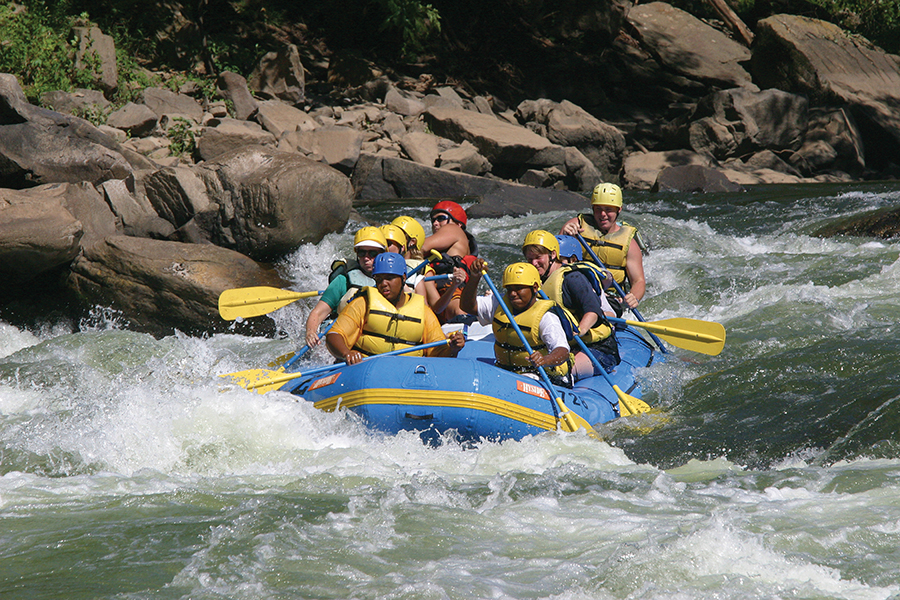Want to spice up your family’s next weekend getaway? Try a whitewater rafting trip on one of West Virginia’s wild rivers.
By Deborah Huso
HQ 55 | SPRING 2005
Sometimes those weekend family trips can feel a little more like obligation than fun, especially when trying to coordinate the interests of mom, dad and the kids. But you can start the summer off right this year with a weekend adventure that will excite the whole family. No need to head to an amusement park. Take the wildest ride of your life on a whitewater rafting trip down the New and Gauley Rivers.
The New River’s name is something of a misnomer. It’s actually one of the oldest rivers in North America, winding its way from North Carolina, across the lower portion of Virginia, and into the mountainous reaches of West Virginia, where it shoots precariously through the Grand Canyon of the East – the New River Gorge. With an average width of nearly a mile and depths plunging to 1,300 feet, the gorge is one of the mountain state’s most spectacular natural features.
But visitors to the New River Gorge don’t have to be satisfied with viewing the cliffs and the water from hundreds of feet above the action. For those who want a Type-T adventure with rapids that rival Arizona’s wild Colorado River, whitewater rafting the New River is one of the best ways to tour the gorge. While the upper level of the river is fairly calm, the lower section has Class IV and V rapids, which can make for a pretty roiling ride.
Whitewater rafting companies here number in the dozens. Class VI River Runners, which is located just a few miles from the Canyon Rim Visitor Center near Fayetteville, is one of the most highly-recommended among rafters in the know and offers trips April through October on what is considered one of the best whitewater rafting rivers in the country. Though I wouldn’t consider myself a Type T thrill seeker, I just had to try it.
I scheduled a sunset trip with Class VI and set myself up for an afternoon ride down the lower section of the river. The New is surprisingly placid in places, and much of the trip consists of slow drifting alongside the CSX railroad tracks that bisect the gorge, giving plenty of space to catch one’s breath between the foaming froth of angry water. And most rafting companies, including Class VI, allow kids on the New as young as six, though the more challenging lower section of the river has a cut-off age of 12.
My rafting cohorts ranged from buff college students and giggling youngsters to middle-aged daredevils and hesitant grandparents. While the New may offer a wild ride, rafting guides ensure that all ages and skill levels learn the ropes before hitting the whitewater. There’s ample time for enjoying the scenery along the way and calm water periods when some of us jumped into the river to glide gently through Class I rapids “raftless.”
But the journey gets serious when whitewater comes into view. The seven-mile sunset trip courses through rapids ranging from Class I to Class V, and in the beginning, even Class II rapids seemed a little terrifying, as water poured in over the boat, tossing me from my seat and sometimes to my knees.
But after four hours on the New, our group of seven was navigating Class IV and V’s with a little less fear and a little more skill, learning to move our bodies to the wild rhythms of the water, coursing by boulders, sailing over rocks, and sometimes paddling air instead of water.
Class VI River Runners knows how to calm the nerves, stopping midway on the trip for cheese, crackers and water, and then offering post-trip beer and soda on the bus ride back to base camp. At Class VI headquarters, showers await for sunset cruisers and then a massive buffet at Smokey’s on the Gorge. Here, tired rafters can enjoy London broil and pork ribs while watching the sun settle gently over the western edge of the New River Gorge.
If you’ve got the muscle power for constant maneuvering, the Gauley River below Summersville offers a whitewater trip that is, in many ways, more challenging than the New. “They are very different rivers,” says Class VI’s Lisa Gale. “The Gauley is narrower, steeper and rockier. It’s a lot bigger workout.”
Dropping 26 feet per mile, the Gauley is open for rafting from spring into fall, but what’s known as “Gauley Season” begins after Labor Day with the lowering of Summersville Lake. With high water volume through narrow, rocky chutes, the Gauley, in season, isn’t a place for child’s play. Class VI requires rafters on this river to be at least 15, so leave the little ones at home. The upper Gauley is home to nonstop whitewater, ranging from Class III to V+ rapids with names like Heaven Help You and Pure Screaming Hell.
If the names don’t instill some trepidation, the water will. But families with teenagers can take a gentler tour of the Gauley in summer in “duckies.” The ride is still rough, however. Come ready to paddle.
To find a whitewater rafting tour that suits your family’s skill and interest levels, visit the West Virginia Professional River Outfitters Association (WVPRO) online at www.wvrafting.com or call 1-800-CALL-WVA. Age limits will vary depending on companies and rafting tours. Be sure to ask when making advance reservations.
For those who aren’t quite ready for whitewater rafting, a jet boat ride with Captain Rick Larson of New River Jet Boats is the next best thing. Accessible via the scenic tram at Hawk’s Nest State Park off Route 60 at Ansted, New River Jet Boats offers a less intense ride down the river to the New River Bridge on a 21-foot jet boat. The six-mile long ride cruises, sometimes bumpily, past the forested steep walls of the gorge, along CSX Railroad’s track, and past ramshackle fishing camps at river’s edge. You can reach New River Jet Boats at 304-469-2525.
Both the New River and the Gauley River are located within the bounds of federal land under the authority of the National Park Service. The New River Gorge National River was established in 1978 to protect 53 miles of the New as it flows through gorge walls ranging from 700 to 1,300 feet in depth and 70,000 surrounding acres. The New drops nearly 250 feet in 14 miles, making it the biggest whitewater river on the East Coast.
The Gauley is part of the Gauley River National Recreation Area, designated in 1988. It protects 25 miles of river through a gorge averaging 500 feet in depth. Unlike the New River Gorge, which is accessible to visitors by automobile and by hiking trails, the gorge through which the Gauley passes is virtually inaccessible save by water.
For more information, visit the rivers online at www.nps.gov/neri or www.nps.gov/gari.





